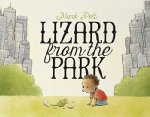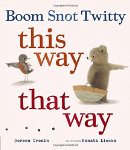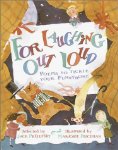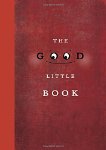
I used to make quilts and loved taking dozens of small pieces of fabric and turning them into a beautiful piece of art that people could snuggle under on a cold day. I was therefore naturally drawn to this poetry book, and was amazed to see how the author created picture quilts that so perfectly complemented her image-rich poems.
Pieces: a Year in poems and quilts
Anna Grossnickle Hines
Poetry Picture Book
For ages 6 to 8
HarperCollins, 2003, 978-0060559601
Writers and illustrators have, over the centuries, found
many ways to describe and celebrate the seasons. Poetry is often a format that
writers are drawn to using, as the lyrical nature of poems seems to so
beautifully ‘fit’ what they are trying to say about the seasons. Often these
poems are paired with artwork or photographs that help encapsulate the image or
feeling that the poet is trying to capture.
Anna Grossnickle Hines has done something a little different. She pairs
the poems she has written with photos of quilts that she has created, and the
effect is quite astonishing.
The poet begins
in spring with a poem called Ballet.
In the blank verse poem she describes how a crow lands on a cedar branch and
how the weight of the bird causes the branch to bounce and the bird to dance. A
beautiful quilt shows the crow about to land on the branch, rectangles and
triangles of sewn fabric in tones of green forming the fronds at the ends of
the branches.
Green plays a
big role in another poem, Do you know
Green? Here we see a scene that perfectly captures the colors and textures
of spring. The poem describes how “Green sleeps in the winter,” until, with the
warming of the sun it, “comes… / tickling the tips / of twiggy tree fingers.”
In summer we see
cows in a field. With a “Scrunch, / crunch, / munch,” they eat their lunch,
their tails twitching. Summer is also a time when there is “a mass of wild
confusion” of flowers blooming. The “rousing-raucous” celebration of colors and
scents stirs us “to jubilation.” During the warms days, hummingbirds “zip zip”
and “sip sip” amongst the flowers of the honeysuckle vine.
Then the tone of
the poems and the colors of the quilts shift for fall. Now the green has been
replaced with reds, golds, and rusts. We see leaves drifting down singly or in
groups, “swirling / and whirling / twisting / and twirling.” Other leaves
“skip-a-dip” and others “just drop / flop.”
Winter brings
the greys and blacks of tree branch silhouettes, the pale yellow of a winter
sun, and the whites and blues of snowfall. We read about how sometimes, when
the author is sleeping at night, “outside / the world is turning / white.”
At the back of
the book the author explains how she created the remarkable quilts that illustrate
her poems. We learn how much time and careful effort goes into creating the
quilts, and how the author designs them. We learn too that often seams have to be
taken out and redone to get the effect the author is looking for.

















